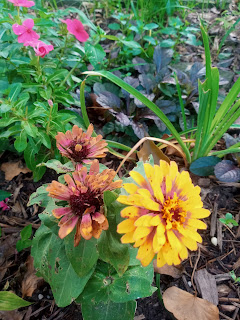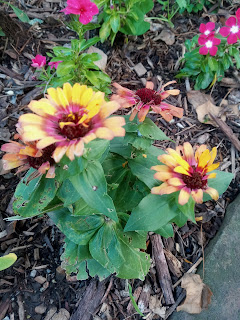A few years ago when I was
hiking in the woods by my home I came across the yellow flowers of the
coreopsis. I noted that butterflies were
in the area and decided to dig up one of the plants for my yard. I grew the coreopsis amongst black-eyed
Susan’s, ornamental grasses, spiderwort and liatris. I liked the mix of plants as they were very
eye appealing.
I planted the coreopsis by digging a
hole that was deep enough to cover the roots.
The soil was amended with compost and I firmed the soil around the plant
stem before watering it. I kept the soil
evenly moist and the plant grew quickly and produced many flowers.
 |
| Coreopsis flowers and peppermint |
When the first batch of flowers
were spent I removed them and sowed the seeds back into the garden. The seedlings grew in and
soon I had a 9x18 area of prairie flowers.
These flowers will continue to bloom throughout summer provided they
have 1 inch of water per week. The roots
are shallow and tend to dry out quickly.
It is better to hydrate coreopsis once a week with a deep root watering than to water during the week. If you live in a climate that has mild summers then no need to water. You can watch your plant and water as needed. My summers are brutal with temperatures well into the 100's F. I will water my coreopsis twice a week in the morning with soaker hose. Plants receive 1/2 inch of water twice a week.
Planting tips for Coreopsis
The coreopsis is not picky about the
soil and will grow in sandy, rocky or fertile soils provided it is well
drained. Grow coreopsis easily from seed.
You can sow seeds outdoors 8 weeks prior to fall frost, or sow seeds in
the spring after the danger of frost has past. You can also buy a
seedling in a nursery grown pot from your local garden center.
If you are sowing seeds into the
ground then sow them 12 inches apart and cover with one inch of soil. Water the seeds so that the ground is evenly
moist. Take care of your seeds by
covering them with a thin layer of organic mulch. I have many birds in my area and so I covered
my newly planted seeds with a thin layer of pine needles. Continue to water the seedlings so that the
soil is evenly moist but not wet.
Coreopsis is mature when the plant is 18-24 inches in height.
The plant grows into a clump and
multi stems grow out of this six inch clump.
This plant will thrive in poor soil and is semi drought tolerant.
View gardens of coreopsis here:
Remove the spent blooms, this will
encourage repeat flowers.
Feed the plants in spring with water
based fertilizer. I use spray-n-grow and
the plants will grow stronger and healthier.
Tips
- Leave
seed heads on the plants at the end of summer so songbirds
have
food.
- Cut back plants to the soil surface
after a hard frost and then apply two to three inches of organic mulch; straw,
wood chips or pine needle mulch.
- Groundhogs and leafhoppers will eat
the flowers, leaves and stems. You can
repel the groundhogs by putting up a fence or by enclosing your garden with
chicken wire fencing. Use natural
insecticide Pyrethin which is formulated with chrysanthemums to get rid of leafhoppers, "brown grasshopper".
- Coreopsis will multiple the
following spring. Divide to prevent
overcrowding.
- This bright yellow flower
that will bloom from early summer to fall.
- Butterflies are attracted to the coreopsis flower and will forage from the
nectar.
- Coreopsis seedheads provide
forage for songbirds in the fall.















